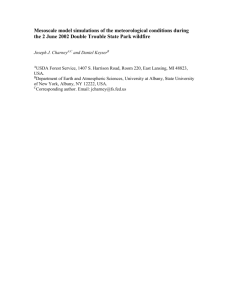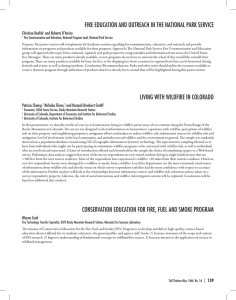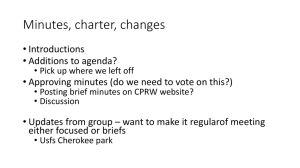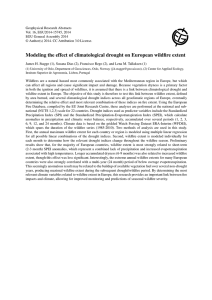L I '?Lsw Wildfires
advertisement
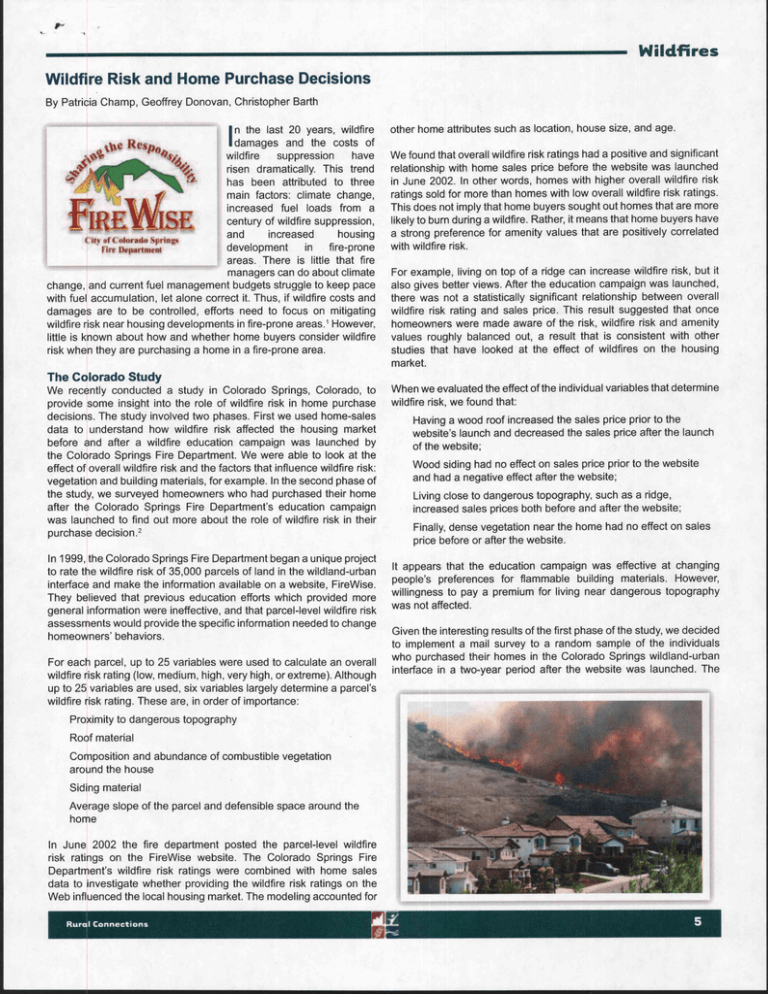
Wildfires Wildfire Risk and Home Purchase Decisions By Patricia Champ, Geoffrey Donovan, Christopher Barth _L I n the last 20 years, wildfire damages and the costs of i t wildfire suppression have " risen dramatically. This trend has been attributed to three main factors: climate change, increased fuel loads from a century of wildfire suppression, and increased housing -sl*(rr development in fire-prone areas., There is little that fire -v " * . managers can do about climate change, and current fuel management budgets struggle to keep pace with fuel accumulation, let alone correct it. Thus, if wildfire costs and damages are to be controlled, efforts need to focus on mitigating wildfire risk near housing developments in fire-prone areas.' However, little is known about how and whether home buyers consider wildfire risk when they are purchasing a home in a fire-prone area. L '?Lsw other home attributes such as location, house size, and age. We found that overall wildfire risk ratings had a positive and significant relationship with home sales price before the website was launched in June 2002. In other words, homes with higher overall wildfire risk ratings sold for more than homes with low overall wildfire risk ratings. This does not imply that home buyers sought out homes that are more likely to bum during a wildfire. Rather, it means that home buyers have a strong preference for amenity values that are positively correlated with wildfire risk. For example, living on top of a ridge can increase wildfire risk, but it also gives better views. After the education campaign was launched, there was not a statistically significant relationship between overall wildfire risk rating and sales price. This result suggested that once homeowners were made aware of the risk, wildfire risk and amenity values roughly balanced out, a result that is consistent with other studies that have looked at the effect of wildfires on the housing market. The Colorado Study We recently conducted a study in Colorado Springs, Colorado, to provide some insight into the role of wildfire risk in home purchase decisions. The study involved two phases. First we used home-sales data to understand how wildfire risk affected the housing market before and after a wildfire education campaign was launched by the Colorado Springs Fire Department. We were able to look at the effect of overall wildfire risk and the factors that influence wildfire risk: vegetation and building materials, for example. In the second phase of the study, we surveyed homeowners who had purchased their home after the Colorado Springs Fire Department's education campaign was launched to find out more about the role of wildfire risk in their purchase d e c i ~ i o n . ~ In 1999, the Colorado Springs Fire Department began a unique project to rate the wildfire risk of 35,000 parcels of land in the wildland-urban interface and make the information available on a website, FireWise. They believed that previous education efforts which provided more general information were ineffective, and that parcel-level wildfire risk assessments would providethe specific information needed to change homeowners' behaviors. For each parcel, up to 25 variables were used to calculate an overall wildfire risk rating (low, medium, high, very high, or extreme). Although up to 25 variables are used, six variables largely determine a parcel's wildfire risk rating. These are, in order of importance: Proximity to dangerous topography Roof material Composition and abundance of combustible vegetation around the house Siding material Average slope of the parcel and defensible space around the home In June 2002 the fire department posted the parcel-level wildfire risk ratings on the FireWise website. The Colorado Springs Fire Department's wildfire risk ratings were combined with home sales data to investigate whether providing the wildfire risk ratings on the Web influenced the local housing market. The modeling accounted for When we evaluated the effect of the individual variables that determine wildfire risk, we found that: Having a wood roof increased the sales price prior to the website's launch and decreased the sales price after the launch of the website; Wood siding had no effect on sales price prior to the website and had a negative effect after the website; Living close to dangerous topography, such as a ridge, increased sales prices both before and after the website; Finally, dense vegetation near the home had no effect on sales price before or after the website. It appears that the education campaign was effective at changing people's preferences for flammable building materials. However, willingness to pay a premium for living near dangerous topography was not affected. Given the interesting results of the first phase of the study, we decided to implement a mail survey to a random sample of the individuals who purchased their homes in the Colorado Springs wildland-urban interface in a two-year period after the website was launched. The c " . I . Wildfires Wildfire Risk and Home Purchase Decisions - continued results showed that wood roofing and wood siding were rated by survey respondents as undesirable characteristics, whereas proximity to the foothills and location on a ridge were rated as desirable. Dense vegetation was rated more undesirable than desirable. However, a more complicatedstory unfoldswhen we consider responses to survey questions about the role of wildfire risk in the home purchase decision. Only twenty-seven percent of the survey respondents realized the house they were purchasing was in an area at risk of wildfire before making an offer on the home. Furthermore, sixty-seven percent did not realize they purchased in an area at risk of wildfire until after they moved into the home. Very few of the survey respondents (less than one percent) had accessed the Colorado Springs Fire Department's FireWise website during the home purchase process. However, more residents eventually accessed the website, as sixteen percent of the survey respondents said they had visited the website. We would not expect home buyers to know the wildfire risk rating of a particular home if they had not accessed the Colorado Springs Fire Department's FireWise website, and indeed a comparison of actual wildfire risk to homeowners' perceived wildfire risk suggests that survey respondents underestimated the overall wildfire risk rating of their home. In particular, twenty-one percent of the respondents thought they had low ratings when in fact only one percent did and only thirteen percent thought they had extreme or very high wildfire risk rating when actually twenty-seven percent did. However, actual wildfire risk ratings were correlated with perceived wildfire risk ratings, suggesting homeowners systematically underestimated the risk rating. It is apparent that most survey respondents did not have much knowledge of wildfire risk and most (seventy-five percent) also said they were not concerned about wildfire risk when they purchased their home. Those who were concerned about wildfire risk when they purchased their home had good reason for concern, as they were more likely to purchase homes with extreme or very high wildfire risk ratings. We might expect previous experience with wildfire to influence home buyer concern about wildfire risk. Most (sixty-five percent) of the survey respondents had not owned a home in a fire-prone area prior to moving into their current residence in Colorado Springs. Although many (forty-two percent) of the survey respondents knew someone who was evacuated from her home due to a wildfire, only eighteen percent knew anyone whose home had been damaged or lost due to a wildfire. Survey respondents who had previously owned a house in a location at risk of wildfire were more likely to be concerned wildfire risk when purchased their current home. Knowing someone who was evacuated from hislher home due to a wildfire or knowing anyone whose home had been lost or damaged due to a wildfire did increase concern about wildfire risk. These results suggest that personalexperience is more strongly related to concern about wildfire risk during the home purchase process than knowledge of others' experiences with wildfire. Perhaps this is why despite much media coverage of wildfires, so few individuals were aware of or concerned about wildfire risk when they purchased their home. Conclusion This study provided some interesting insights into wildfire risk and home purchase decisions. Although the Colorado Springs Fire Department's FireWise program and the parcel-level wildfire risk ratings did not specifically target individuals moving into the area, the program appears to have changed home buyer preferences for some home characteristics that are related to wildfire risk. Nevertheless, home buyers did not seem to be very knowledgeable or concerned about wildfire risk. And while they underestimated the wildfire risk rating of their homes, perceived and actual wildfire risk ratings were positively correlated. As noted earlier in this article, migration to fireprone areas is a major contributor to increasingfire suppression costs. home buiers could have significantfinancial payoffs for the home buyers themselves and the taxpayers who fund fire suppression efforts. We conclude that providing parcel-level information about the wildfire risk that targets individuals moving into fire prone areas might be an effective approach to education. ducati in^ Endnotes 1. According to the OfFice of Inspector General, the cost of protecting private property from wildfires constitutes between 50 to 95 percent of all firefighting costs in recent years. 2. The details of the study are summarized in Donovan, Champ, and Butry (2007a,b) and Champ, Donovan and Barth (forthcoming 2008). References Champ, P.A., G.H. Donovan, C. Barth. Forthcoming. "Home buyers and Wildfire Risk: A Colorado Springs Case Study." Society and Natural Resources. Donovan, G., P.A. Champ, D. Butry. 2007a. "The Impact of Wildfire Risk on Housing Price: A Case Study from Colorado Springs." Land Economics 83(2):217-233. Donovan, G., P.A. Champ, D. Butry. 2007b. "Measuring the efficacy of a wildfire education program in Colorado Springs." Journal of Emergency Management 5(3):33-37. About the Authors Patricia Champ is an economist with the U.S. Forest Service who studies nonmarket valuation methods and social and community aspects and effects of wildfires, among other things. Her research on policy and institutions has yielded publications for Land Economics, Environmental and Resource Economics, and other journals. She is also a member of Western Economics Association International and Association of Environmental and Resource Economists. Geoffrey Donovanworks as a ,Research Forester for the USDA Forest Research Station in He works out of the Pacific Portland, Christopher Barth works as a firefighter for the Colorado Springs ~i~~ ~ ~ ~ incolorado ~ rsprings, t colorado, ~ ~ He coordinates ~ t and oversees the Fire Department's Fire Wise program, which helps local residents learn about wildfires and protect their homes, Rural Connections I

